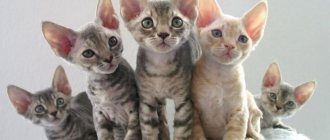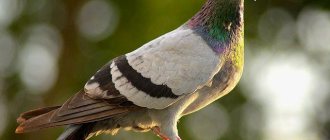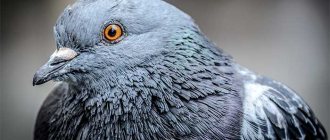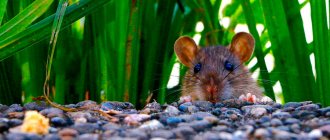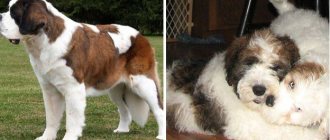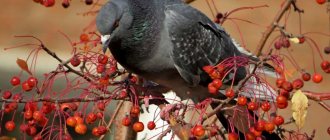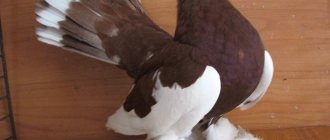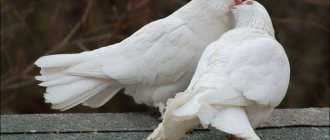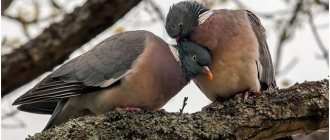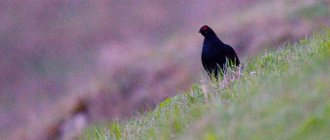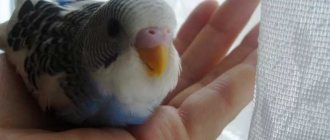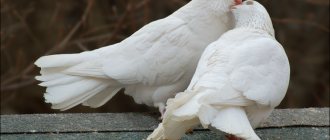Home » Articles about pigeons » Wild pigeon
Wild pigeons were domesticated by humans many thousands of years ago. Since then, breeds of different colors and appearance have been bred, but birds existing in the natural environment are no less interesting. They live on almost all continents. There are 35 species in the pigeon family, but only a few of them are widespread.
Types of pigeons
There are many varieties of pigeons, but among such diversity there are wild pigeons, decorative pigeons, homing pigeons, and meat pigeons. This set of species consists of pigeons and turtle doves, living both in Europe and beyond. The largest number of species can be found in: South and Southeast Asia, as well as Australia.
Some species of pigeons inhabit wooded areas, as well as tropical rainforests. Some species, such as the rock pigeon, have easily adapted to the harsh life in megalopolises and other cities, so they can easily be found in all cities of the globe, and in fairly large quantities.
Klintukh is a type of wild pigeon. This species is distinguished by its bluish plumage, greenish neck, red craw, and blue-gray wings. At the same time, black stripes can be seen on the tail.
The habitat of this type of pigeon extends to the north of Kazakhstan, the south of Siberia, Turkey, Africa and China. Pigeons are also migratory if their natural habitat is associated with cold regions. At the same time, living in regions with a warm climate, pigeons prefer to lead a sedentary lifestyle.
The crowned pigeon is also a wild species of pigeon, and its habitat is associated with tropical countries, such as New Guinea. Here it lives in humid forests, mangroves, and tropical jungles. The pigeon is so called because it has a unique crest, which, depending on the psychological state of the bird, either rises up or falls to its original position.
Interesting to know! The wood pigeon is one of the largest representatives of this genus. Only its tail is about 15 cm long. The neck of this pigeon has a bright greenish tint. The habitat of this bird is no less extensive, since the pigeon is distributed throughout the Euro-Asian continent. The wood pigeon can live in any climate zone without any problems.
As mentioned above, there are also meat breeds of pigeons that are bred artificially on poultry farms.
There is also such a type of pigeons as carrier and flying pigeons. Unfortunately, in our era of the Internet and high-tech communications, the functions of carrier pigeons are a thing of the past. Therefore, only connoisseurs of true beauty and connoisseurs of unique breeds are interested in these types of pigeons.
Wood Pigeon
Wood pigeon or vityuten is a large forest bird, a desirable prey for hunters
This species has another name - vityuten. The main characteristics of the breed are as follows:
- the body reaches 45 cm in length;
- the tail is 66-77 cm;
- bird weight - about 650 g;
- wingspan is 70 cm or more; when taking off, the pigeon flaps them loudly;
- the color of the plumage is bluish-gray, although the feathers on the back may have a bluish-brown tint;
- the neck and breast are grayish-red;
- the wax and beak are pinkish, the tip is yellow.
Males and females do not differ in color from each other.
In addition to Europe, wild pigeons of the wood pigeon breed are also common in Turkey and the Himalayas, Iran and Iraq. It is interesting that in the northern regions they lead a nomadic lifestyle, but in all other zones they prefer to live in one place. The birds choose deciduous, coniferous or mixed forests as their habitat, although they are often found in the squares of large cities.
They fly to Moldova for the winter. Upon returning, the entire flock soon divides into pairs, which begin to build nests and lay eggs.
The pigeon is predominantly a forest pigeon. Wood pigeons prefer to build their nest at a high height, 10 - 12 meters, choosing for this the tallest trees with a dense crown. The nest is assembled entirely from twigs, and if you look at it from below, it is translucent through. Each branch for the nest undergoes the strictest selection.
Birds are very shy. If you frighten a pigeon by driving it away from its home, the wood pigeon most often does not return.
Each female wild pigeon usually lays two or three eggs in the nest. The female and male hatch them alternately. Chicks are born after 15 - 17 days. Their parents feed them pigeon milk - a special type of food that they produce in their crops. The chicks simply drink it, dipping their beaks into the crop of their father or mother. A week later, they begin to be given regular food, and a month and a half after birth, the grown chicks try to fly out of the nest.
The main food of wood pigeons is plant matter. This includes:
- plant grains;
- acorns and seeds;
- nuts;
- berries and fruits of bushes and trees;
- herbs.
The diet of wild pigeons includes worms and caterpillars, as well as slugs, although this is not their main food.
The male and female wood pigeon incubate the eggs in the nest in turn.
Adult birds collect food from tree branches or sit directly on the ground, pecking at fallen fruits or grains. When feeding, wood pigeons sometimes show miracles of acrobatics - the bird can easily hang on a branch upside down, reaching with its beak for the nut it likes.
The danger for them is:
- in the sky - larger birds of prey;
- in the trees there are forest predators. The same marten is capable of climbing a tree and destroying a pigeon’s nest;
- on the ground there are foxes and badgers. Since individuals of this breed are quite large, they cannot take off instantly, so they are in serious danger on the ground.
Birds of prey - the main enemies of wood pigeons - have become fewer and fewer in recent years, due to which the population of the breed is gradually growing. On the other hand, in many countries, representatives of this species are considered pests and are diligently reducing the number of birds, shooting thousands of birds every year, not allowing them to build nests, etc. But wood pigeons are not yet in danger of becoming an endangered species, given their number on the planet.
Appearance, description
The crowned pigeon, which lives in Papua New Guinea, is considered the largest representative of this family. Adults weigh between 1.7-3 kilograms. The smallest representatives include the diamond striped dove, which lives in Australia. It weighs no more than 30 grams.
Interesting moment! Pigeons are small birds, growing in length from 15 to 75 cm and can weigh from 30 grams to 3 kilograms.
Pigeons are characterized by a very muscular physique. Their neck is short and their head is small. The wings are relatively long and wide, consisting of 11 primary flight feathers, as well as 10-15 secondary ones, with rounding at the tips. The tail is also relatively long, and can be either pointed or rounded, as well as wide. As a rule, the tail consists of 12-14 feathers, and in crowned and pheasant pigeons - up to 18.
The beak of these birds is generally short, but is found to be of medium length, straight and thin, often with a characteristic widening at the very base. The base of the beak is characterized by the presence of areas of skin not covered with feathers, which are scientifically called cere. The same areas can be observed within the eyes.
Sexual dimorphism in these birds is not clearly expressed, although males are always larger than females. In some species living in the tropics, the feathers of males are more brightly colored than those of females.
The birds have thick plumage, close to the body, of various tones, but not as bright as some tropical species. The legs of pigeons are relatively short, four-toed, with three toes located in front and one behind. This structure allows pigeons to walk on the ground without problems.
It is quite easy to determine whether a bird belongs to the Pigeon family using morphological characteristics, although some species have an external resemblance to birds such as pheasants, partridges, parrots and turkeys.
Important point! Pheasant pigeons are similar in appearance to pheasants, although many people do not know that they are not pheasants, but pigeons.
Pigeons, like some other bird species, lack a gallbladder. Even in ancient times, a similar fact misled naturalists who believed that pigeons do not produce bile. This conclusion was confirmed by one of the theories of the 4 body fluids. In this regard, the absence of bile secretion in pigeons was considered a sign of the “divinity” of the bird. In fact, pigeons secrete bile, but it goes straight into the digestive system.
Pigeons | Jumanji. Animals in the metropolis
Peacocks
A popular decorative breed in the world, which received its unusual name due to the shape of the tail. All varieties of this pigeon breed are distinguished by their elegant tails.
In the luxurious tail you can count up to 40 long feathers, collected in a peacock fan. The lush feathering on the legs adds integrity to the original image. In appearance, they are really very similar to peacocks.
The chest is proudly pushed forward, there is a crest on the head, and the wings are beautifully folded along the massive, rounded body. Due to their unusual appearance, these birds are most often depicted on posters as doves of peace.
11
Natural habitats
Pigeons live on almost all continents, with the exception of the North and South Poles. These birds inhabit various terrestrial biotopes, from dense forests to deserts, as well as mountainous areas at altitudes of up to 5 thousand meters, including in areas where humans operate. About 60 percent of pigeon species inhabit islands and are not found on mainlands.
There are 9 species of similar birds found on the territory of Russia, and the largest number of currently existing species live in South America and Australia.
Lifestyle
Wild pigeons for their livelihoods choose areas located on river banks, in coastal rock formations or in mountain gorges. This is especially true in relation to the fact that pigeons try to build a nest for themselves in hard-to-reach places. These birds have always been attracted to farmland as a source of food, so the relationship between man and these birds has been formed over many centuries, although over such a long period of time man has not become less fond of these birds.
These birds are easily domesticated, so humans have always tamed them in order to then take advantage of their unique capabilities. Of particular interest are carrier and flying pigeons, which were always close to humans. For this, man created suitable living conditions for pigeons. The decorative species of pigeons is kept by many connoisseurs of these unique birds around the world.
Jacobins
Decorative pigeons of the Jacobin breed have a characteristic decoration in the form of a unique collar consisting of feathers. The feather necklace not only surrounds the head, but also covers it and the neck. To prevent the chicks' collar from being damaged during incubation, it is trimmed a little. The Jacobin has a rather slender exterior with a long, pronounced neck. The color palette of Jacobin plumage is extremely wide. The tail of the breed is long, while the legs are quite short. They fly slowly and much worse than their other counterparts. But they are highly productive and are good parents. There is also a variety of English wig Jacobins, which received this nickname because of the plumage of the head, somewhat reminiscent of an ancient wig.
Since decorative pigeons are very shy, it is necessary to care for and handle them delicately and carefully, constantly monitoring their behavior. They fly poorly due to poor vision, which is negatively affected by the feather wig. Currently, Jacobins are the most popular types of decorative pigeons, although their characteristics are noticeably inferior to similar foreign breeds of birds.
Curly
Every self-respecting pigeon owner dreams of having a curly-haired pigeon in his collection. Its curly plumage is so attractive that it looks impressive even with a monotonous gray color. The most curled feathers of this breed are located on the wings and legs.
Peacock
From the point of view of pure decorativeness, it is difficult to find a rival to the peacock pigeon. Its main distinguishing feature is its very wide tail and very lush feathers, which together create a structure that strongly resembles a flowing peacock tail. The peacock breed of white pigeons is the most popular among pigeon breeders, although other colors are also found in dovecotes. Very often, such pigeons are used for wedding ceremonies and circus performances.
Bohemian space-footed fairy swallow
This unique breed of decorative pigeons was bred in the Czech Republic. A distinctive feature of this breed is the coloring of the pigeon’s legs and wings, reminiscent of the coloring of swallows. The dimensions of the Bohemian spacefoot are quite large, but the main difference is the special plumage of the legs.
Barb
Barb pigeons can be distinguished from other breeds by the specific pink growths located around the eyes, which is why these types of pigeons are classified as warty pigeons. Barbs have a prominent, conspicuous forehead and a short beak. They cannot boast of variegated colors: most often they are white, sometimes other solid colors.
Berlin long-billed
All those who were able to see this species of pigeon can consider themselves lucky, since Berlin long-billed pigeons are found only in a few cities in Germany. Their beautiful appearance has made them popular, especially the vertical position of the neck, while the body, head and beak are horizontal. Berliners have a thin, long beak (hence the name of the breed) and a very narrow head.
German monk
This ancient breed of decorative pigeons was bred in the seventeenth century in the same Germany. “German monks” do not fly very high and confidently, but this did not stop them from being used to lure other people’s pigeons, because in the past it was often practiced to kidnap birds from other people’s pigeon coops. The appearance of pigeons of this breed is quite ordinary, perhaps, except for the feather hood placed on the back of the head. However, recently, very ordinary individuals with smooth heads are appearing more and more often.
Saxon priest
For those who want to diversify the population of their own dovecote, we can recommend having a “Saxon priest”, whose appearance is distinguished by the presence of long feathers on the legs and two crests on the head. This pigeon can have a variety of colors, except for the forehead, which is always white.
Brno blower
Pigeons of this breed have an upright posture and a slender body. From a distance, you might think that the body of the pigeon below the crop is tied with a belt. It was the swollen, hypertrophied crop that gave this breed its name.
Another important distinguishing feature of the breed is its gait, which relies not on the entire foot, but only on the toes. That is, the pigeon walks all the time, as if on tiptoe
The review included only a small part of the existing decorative breeds of pigeons - in addition to them, many more beautiful birds were bred.
Video about decorative breeds of pigeons
Diet of pigeons
Interesting Facts! The diet of pigeons is based on food items of plant origin, in the form of leaves, seeds and fruits. As a rule, pigeons swallow fruits with seeds, and then the seeds are regurgitated back. Pigeons feed on seeds either fallen from the surface of the ground, or pluck them directly from plants using their beaks.
The Galapagos dove is distinguished by the fact that it searches for seeds in the thickness of the earth; for this, it picks up the soil with its beak. Pigeons can also feed on small invertebrates, but part of this food in the pigeons’ diet is very insignificant. Naturally, pigeons drink water, but in an unusual way for birds: they suck the water inside. To find water for themselves, pigeons sometimes fly great distances.
Golden motley
This unusual bird (of the pigeon family) lives on the islands of the Pacific Ocean. Looks very elegant. Its plumage, shimmering in the sun, shimmers with a golden sheen. The bird, having a limited habitat, eats fruits, berries and insects. Females, unlike males, have greenish plumage. The length of this tropical bird is about 20 cm.
The main feature of the golden motley dove is its feathers. They look so stylish and unusual, as if the bird had been styled at a hairdresser. This type of plumage is associated with the unusual structure of the feathers - it is close to the structure of hair. This elegant bird has turquoise-colored paws, and the skin around the eyes and beak, painted in the same color, harmoniously complement the image of this small but bright bird.
Reproduction, lifespan
The reproduction of these birds depends on egg laying. If pigeons are kept at home, then the laying of eggs can be predicted by the behavior of the female. A couple of days before this, she becomes inactive and often sits in the nest. The process of laying eggs occurs a couple of weeks after fertilization.
A pair of pigeons builds a nest for themselves, and the male finds and brings the necessary building material, and the female forms a nest from it. In their natural habitat, these birds live for about 5 years, since they have many different enemies. If you keep pigeons at home, providing them with suitable conditions, then pigeons can live 3 or even 5 times longer.
Natural enemies
You cannot envy pigeons, since they have quite a lot of natural enemies. Pigeons are hunted by feathered predators such as falcons, marsh harriers, kites and others. They attack these birds right in the air. On the ground, surprises await these birds, in the form of martens, ferrets, cats and even rats.
Almost wherever pigeons live, all predators are not against feasting on pigeons. When keeping pigeons at home, you need to make sure that no predator in the form of a ferret or the most common rat gets to the pigeons. These rodents pose a serious danger to newly born chicks.
Why is the dove considered the bird of peace?
Even in ancient times, it was believed that a dove was a bird created pure and good by God himself, since it does not have bile, which means there is nothing bad. In this regard, many nationalities believed that this bird was sacred, and therefore associated it with bountiful harvests. The Bible also mentions a dove that brought peace to people.
Interesting to know! The “dove of peace” symbol appeared thanks to the world famous artist P. Picasso, who presented his next painting in 1949. The canvas showed a dove with an olive branch in its beak. From that moment on, the image of the dove as a bird of peace was finally established.
Dove and man
Humans and pigeons have a centuries-old history. In ancient times, when the means of delivering information were not fast and reliable, people resorted to the help of carrier pigeons to quickly deliver letters. “Meat” types of pigeons were also known. In the culture of many peoples of the world, a certain place is reserved for pigeons. At the same time, pigeons are mentioned both in the Bible and in Sumerian mythologies. Nowadays, there are people called “pigeon keepers” who devote all their time to keeping and caring for pigeons.
Homing pigeons
There are a sufficient number of types of homing pigeons, but 4 of them are of particular interest: English Quarry, Flanders, Antwerp and Lüttich. All homing pigeons are of medium size and differ from other representatives by a kind of increased “sense of home.” In addition, they fly at a speed of about 100 km/h and have high endurance. Nowadays, carrier pigeons are practically not used to deliver correspondence, but purely sporting interest in them has not faded away.
Breeds of pigeons
Russian flying breeds
Since ancient times, it was customary to keep pigeons in Rus'. Our ancestors greatly revered such birds. By the way, people of noble origin often used pigeons for hunting and sports. That is why there are many Russian breeds with excellent flight qualities. What types of pigeons should be considered domestic? Let's introduce some of them:
Permians
This breed is ancient, but there is another one that came from it, a modern one, bred only about a hundred years ago. She continues to improve even now. Its representatives are famous for their flight altitude, and in this indicator they surpass many foreign flying breeds.
The average size of such pigeons is only about 33 cm. Traditional Perm pigeons have white plumage, and their appearance is complemented by a red or blue mane, that is, a spot on the back of the neck. The feather robe of the newest purebred specimens can be multi-colored or monochromatic: black, white, rich red or yellow.
Voronezh White-throated
The flight qualities of these birds are also unusually high, and their time in the air can reach up to two hours. They are strong in build and have excellent muscles. Their smooth plumage is the basis of a multi-colored outfit and is complemented by an original ornament. Their neck is white, and on the back of their heads there is an interesting crest of the same color.
Domestic pigeons
Domestic pigeons are kept by those people who are passionate about the beauty of these birds. Often pigeons are bred for meat, although we can immediately say that this is rare. Domestic pigeons are distinguished by a variety of colors, which attracts pigeon lovers.
The tippler pigeon breed is considered the most popular today, especially among lovers of European countries. Pigeon lovers in Russia know about the existence of this breed, but it is not so easy to get one, since it is difficult to find females, although the breed is not considered rare.
In fact, this breed is not much different from other types of pigeons. They have gray plumage, and in the neck area you can see a slight sheen. Still, it is worth noting that tipplers have a rather athletic and muscular body. Therefore, they have unique flight characteristics: birds can stay in the air for about 20 hours without landing.
Interesting to know! Hryvnia pigeons are considered decorative birds, but it should be recalled that they were bred by Russian specialists.
This breed is very popular among domestic pigeon lovers. The birds got their name due to the presence of a relatively large mane on their heads. As a rule, hryvnias are a pure white breed, with a patch of either red or black on the neck.
Russian specialists also worked hard and brought out the Armavir cosmachi. These pigeons are not distinguished by excellent flight characteristics, since they rise into the sky to a height of about 100 meters. They can stay in the air for no more than 2 hours. Still, it is worth noting that in flight these pigeons look very attractive, which is why they are very popular among pigeon keepers.
Pigeons turn out to be much smarter than scientists thought.
Over the course of ten years of experiments, pigeons were able to prove that they are capable of thinking. Some people call pigeons "rats with wings." So these “rats with wings,” oddly enough, understand what time and space are.
At one time, an article was published in the journal Current Biology, which indicated that pigeons are able to distinguish between both long and short periods of time, and are also able to calculate time intervals.
At the University of Iowa, researchers presented pigeons with images of short and long lines for short and long periods of time. The task of the birds was to peck at the desired line and receive a reward for this. Oddly enough, the pigeons easily coped with the task, despite the fact that the task was constantly becoming more complicated. They played this size-time game as easily as the monkeys.
After lengthy experiments, it turned out that pigeons are able to switch from one task to another faster than humans. They easily remember human faces and easily distinguish Monet's paintings from Picasso's paintings.
The results of the experiments were quite surprising, since it is believed that birds have a poorly developed part of the brain that is responsible for abstract thinking. In this regard, scientists thought that such tasks for birds were impossible.
Jacobins
Decorative pigeons of the Jacobin breed have a characteristic decoration in the form of a unique collar consisting of feathers.
The feather necklace not only surrounds the head, but also covers it and the neck. To prevent the chicks' collar from being damaged during incubation, it is trimmed a little. The Jacobin has a rather slender exterior with a long, pronounced neck. The color palette of Jacobin plumage is extremely wide. The tail of the breed is long, while the legs are quite short. They fly slowly and much worse than their other counterparts. But they are highly productive and are good parents. There is also a variety of English wig Jacobins, which received this nickname because of the plumage of the head, somewhat reminiscent of an ancient wig. Since decorative pigeons are very shy, it is necessary to care for and handle them delicately and carefully, constantly monitoring their behavior. They fly poorly due to poor vision, which is negatively affected by the feather wig. Currently, Jacobins are the most popular types of decorative pigeons, although their characteristics are noticeably inferior to similar foreign breeds of birds.
Curly
Every self-respecting pigeon owner dreams of having a curly-haired pigeon in his collection. Its curly plumage is so attractive that it looks impressive even with a monotonous gray color. The most curled feathers of this breed are located on the wings and legs.
Peacock
From the point of view of pure decorativeness, it is difficult to find a rival to the peacock pigeon. Its main distinguishing feature is its very wide tail and very lush feathers, which together create a structure that strongly resembles a flowing peacock tail. The peacock breed of white pigeons is the most popular among pigeon breeders, although other colors are also found in dovecotes. Very often, such pigeons are used for wedding ceremonies and circus performances.
Bohemian space-footed fairy swallow
This unique breed of decorative pigeons was bred in the Czech Republic. A distinctive feature of this breed is the coloring of the pigeon’s legs and wings, reminiscent of the coloring of swallows. The dimensions of the Bohemian spacefoot are quite large, but the main difference is the special plumage of the legs.
Barb
Barb pigeons can be distinguished from other breeds by the specific pink growths located around the eyes, which is why these types of pigeons are classified as warty pigeons. Barbs have a prominent, conspicuous forehead and a short beak. They cannot boast of variegated colors: most often they are white, sometimes other solid colors.
Berlin long-billed
All those who were able to see this species of pigeon can consider themselves lucky, since Berlin long-billed pigeons are found only in a few cities in Germany. Their beautiful appearance has made them popular, especially the vertical position of the neck, while the body, head and beak are horizontal. Berliners have a thin, long beak (hence the name of the breed) and a very narrow head.
German monk
This ancient breed of decorative pigeons was bred in the seventeenth century in the same Germany. “German monks” do not fly very high and confidently, but this did not stop them from being used to lure other people’s pigeons, because in the past it was often practiced to kidnap birds from other people’s pigeon coops. The appearance of pigeons of this breed is quite ordinary, perhaps, except for the feather hood placed on the back of the head. However, recently, very ordinary individuals with smooth heads are appearing more and more often.
Saxon priest
For those who want to diversify the population of their own dovecote, we can recommend having a “Saxon priest”, whose appearance is distinguished by the presence of long feathers on the legs and two crests on the head. This pigeon can have a variety of colors, except for the forehead, which is always white.
Brno blower
Pigeons of this breed have an upright posture and a slender body. From a distance, you might think that the body of the pigeon below the crop is tied with a belt. It was the swollen, hypertrophied crop that gave this breed its name.
Another important distinguishing feature of the breed is its gait, which relies not on the entire foot, but only on the toes. That is, the pigeon walks all the time, as if on tiptoe
The review included only a small part of the existing decorative breeds of pigeons - in addition to them, many more beautiful birds were bred.
Which breed of decorative pigeons did you like best, and why? Share your opinion on .
Video about decorative breeds of pigeons
